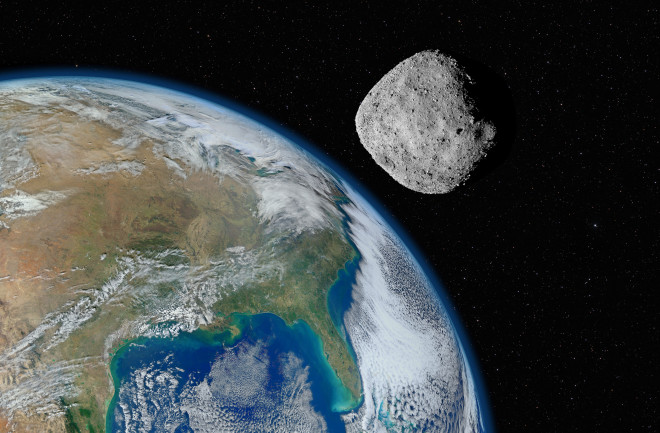For tens of millions of years, the asteroid Bennu traveled through the vacuum of space, likely originating from our own solar system. But one small hunk of debris from the sample brought back to Earth — the first piece of an asteroid ever obtained by NASA — took its most recent trip on a subway car in Washington, D.C.
“The good people at [the Washington Metropolitan Area Transit Authority] can say they transported a piece of Bennu,” says Tim McCoy, curator of meteorites at the Smithsonian National Museum of Natural History, where a new display containing a piece of the asteroid was unveiled on Nov. 3, 2023.
Scientists have already begun to analyze tiny pieces of this far-flung space rock — and initial studies have revealed the presence of both carbon and water, the building blocks of life. Now that the asteroid samples have arrived safely on Earth, the real work is just getting started.
What Is Asteroid Bennu?
Bennu isn’t a single asteroid so much as a collection of cosmic rubble, as it's described by many of scientists who study it. “Think of it like a group of marbles stuck together in space,” McCoy says.
How Big Is the Bennu Asteroid?
In terms of size, the asteroid is about as wide as the Empire State Building is tall, according to a press release from the Smithsonian National Museum of Natural History. Some of debris is quite small, while other parts are boulder-like in size, roughly 100 meters in diameter, says Erica Jawin, a geologist at the Smithsonian Air and Space Museum.
This debris is actually just the material that broke loose from a cosmic collision, likely somewhere in our solar system’s asteroid belt. “Bennu is a second or third generation asteroid,” McCoy says.
How Far Away Is Asteroid Bennu?
Bennu is also classified as a "near-Earth" asteroid, meaning that it has been orbiting the sun and passing close to our planet roughly every six years. “Bennu is one of the many near earth asteroids that are thought to be short lived," McCoy says. "They’re in unstable orbits."
Read More: Asteroids: What They Are and Where They Come From
The OSIRIS-REx Mission
First launched in 2016, OSIRIS-REx (short for Origins, Spectral Interpretation, Resource Identification and Security-Regolith Explorer) was the first mission launched by NASA to collect a sample from an asteroid in space and return it to Earth.
When Did the OSIRIS-REx Spacecraft Land?
About 20 feet across with solar panels deployed, the unmanned spacecraft looks a little like a metal mosquito with a long stinger. After orbiting around the sun for several years following its launch, OSIRIS-REx finally reached Bennu in 2018. The spacecraft observed the asteroid until late 2020, at which point it extracted the sample.
How Did We Get Soil Sample From Bennu Asteroid?
The spacecraft's arm was designed to stick into the asteroid and bounce off, much like a pogo stick, removing a small sample of rock in a special container in the process. The container is so-well protected, in fact, that researchers still haven’t been able to remove the final two bolts to get inside; all of the material analyzed thus far has come from loose bits of the ancient asteroid on the exterior of that vessel.
Ultimately, OSIRIS-REx dropped the sample down in Utah with the help of a parachute in September, before continuing off on another mission to explore the asteroid Apophis.
Read More: 4 Facts About Asteroids You May Not Have Known
What Can We Learn from the Bennu Asteroid Samples?
Both photographs and subsequent analysis of the rocks brought back to Earth have revealed that Bennu is rich in carbon. What's more, the rocks that make up the rubble pile are thought to date back about 4.5 billion years — around the time our solar system was first forming.
Was Water Found in the Bennu Asteroid Samples?
Cari Corrigan, a geologist at the Smithsonian National Museum of Natural History, says that she and her colleagues have already found water in a number of rice-sized rock samples they have analyzed. They are currently working to characterize the material of the asteroid itself, as well as any foreign material that might have come from the OSIRIS-REx spacecraft or elsewhere.
In a larger sense, asteroids like Bennu might tell us more about the kind of asteroid that may have brought water — and ultimately life — to our planet.
“[This is] a part of our question to try to understand who we are, what we are and where we are,” says Bill Nelson, a NASA administrator.
Read More: Scientists Predict Next 1000 Years of Asteroid Impacts
What Does This Mean for Future Generations?
Still, scientists have just begun to understand more about what Bennu contains. Some of the samples stored at the museum will be available for researchers to analyze today. But much of the material will be put aside for future generations to study.
“Your grandchildren can come up with a question we haven’t even imagined now with a technique we haven’t even thought of inventing,” McCoy says. “This is literally the gift that keeps on giving. Decades of scientists will be able to understand the history of our planet, the history of our solar system, from these samples.”
Read More: The Asteroids We Should Watch Out For

